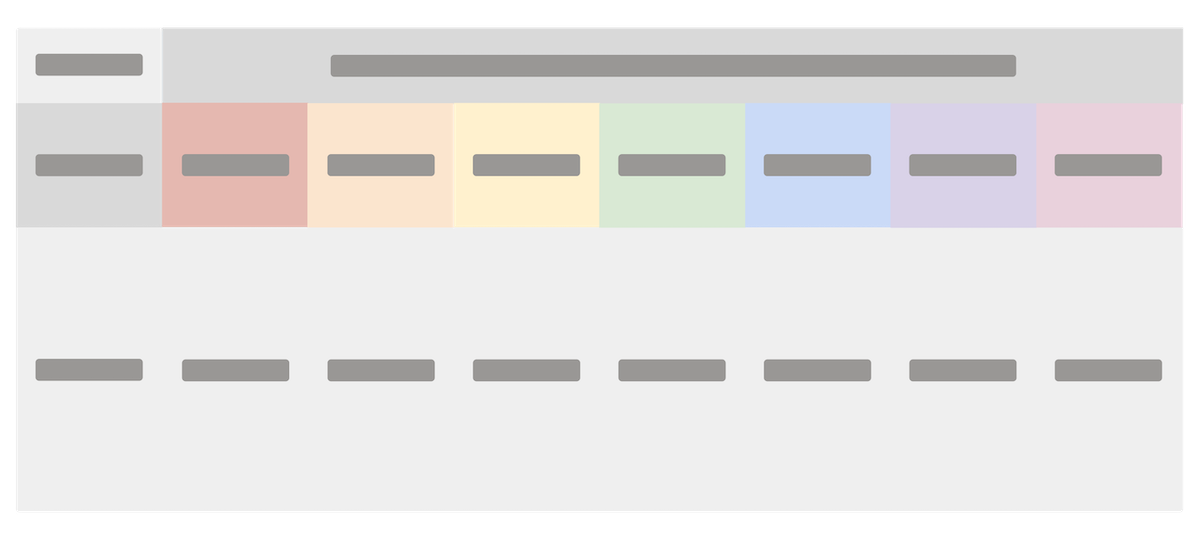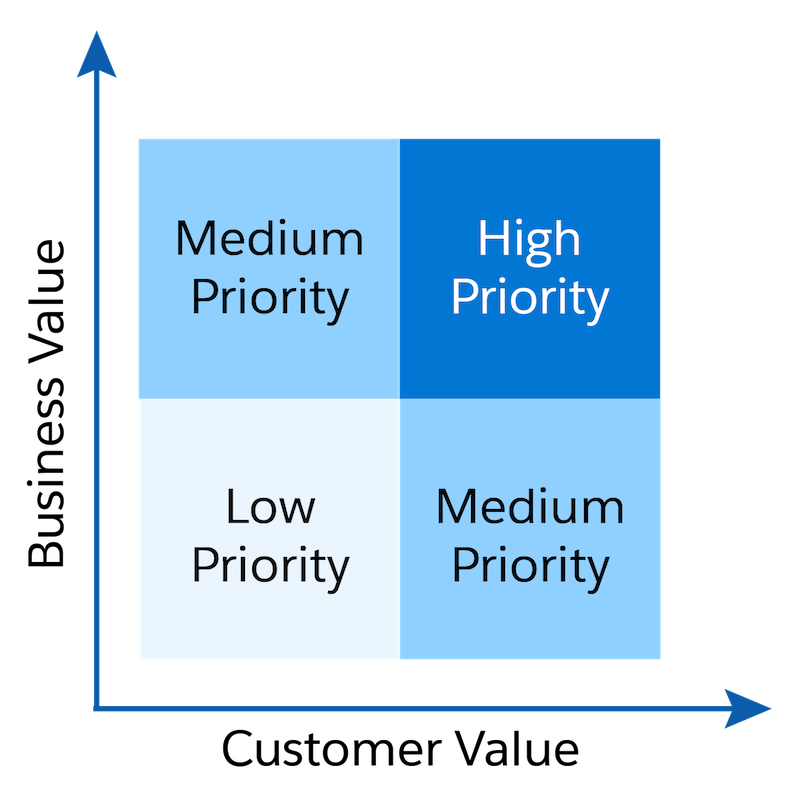Define Your Content Strategy
Learning Objectives
After completing this unit, you’ll be able to:
- Map your content to the customer journey.
- Prioritize your content needs.
- Document your content strategy and create a content backlog.
- Pilot your content strategy.
Assemble the Pieces
Throughout this module, we’ve been following along with Grace as she helps Ursa Major Solar lay the groundwork for a successful content strategy. So far Grace has established business objectives, researched the needs of customers, and evaluated existing content. Now she can assemble all those puzzle pieces and define the company’s content strategy.
Find Gaps in the Content Experience
First Grace needs to determine exactly how, when, and where Ursa Major’s content experience is failing its customers. To do that, she combines her customer journey maps with the results of the content audit to create a brand-new artifact: a content map.
The idea is simple. If you map your existing content to the different stages of the customer journey, you can visualize the end-to-end content experience and make sure your organization is delivering the right content to the right people in the right place at the right time.
Grace is ready to try her hand at creating a content map, so she follows this basic process.
- Pick a persona (or role or whatever audience segmentation makes sense).
- Open the spreadsheet that plots the stages of their journey.
- List existing content assets that address the customers’ needs at each stage. You may want to add details about how, when, and where a customer is most likely to engage with that content.
- Note any content gaps, redundancies, challenges, and areas for improvement.
- Repeat this process for each audience type.

Like journey mapping, it can also be fun to turn content mapping into a group exercise. A collaborative approach can start conversations about the current state of content and how the organization might transform it.
Prioritize Content Needs
You learned earlier that content strategy is a series of tough decisions that focus your organization’s time and resources. Well, it’s time for Ursa Major to start making those decisions. Grace’s next step is to prioritize Ursa Major’s content needs.
Prioritize Your Audiences
As a result of its user research efforts, Ursa Major now has a list of all the audiences who rely on its content. Grace talks to stakeholders and decides which audiences are most important to the business. The company won’t neglect the other audiences; they’re just setting smart constraints so they can make better decisions.
Prioritize Your Customers’ Needs
Now Grace turns her attention to the needs of each specific audience. She ranks those needs according to how much value it will provide to the customer and how much value it will provide to the business.
If your organization is having trouble prioritizing audience needs, try plotting them on a graph like the one below. Use a whiteboard and sticky-notes to turn it into a group activity.

The prioritization process can be tricky, but here’s what it accomplishes.
- It aligns your customers’ needs with your business objectives.
- It establishes a guiding star for all your content initiatives.
And well… that’s the very definition of content strategy!
Document the Strategy
Now that Grace has a handle on all the elements of Ursa Major’s content strategy, the next step is to document it. Capturing the strategy allows her to share it with stakeholders and content teams so that everyone is aligned and ready to forge ahead in the same direction. We recommend creating the following content strategy deliverables.
Content Strategy Brief
The content strategy brief is a document that outlines the strategy at a high level. These are some of the details Grace includes.
- Content vision and roadmap
- Business objectives and metrics
- Prioritized list of audiences and their needs
- Links to the content backlog, content maps, and personas
- Key insights from the content audit
- Summary of the content opportunities and challenges
Content Backlog
With Ursa Major’s freshly minted content strategy comes a whole host of ideas for content projects and initiatives that can help the organization achieve its content vision. But which ideas are worth pursuing?
When Grace is deciding which projects are aligned with Ursa Major’s content strategy, she considers:
- Audience prioritization
- Customer value
- Business impact
- Ease of implementation
- Availability of resources
- Technical constraints
She weighs each idea against those factors, cuts the ideas that don’t provide value, prioritizes the rest, and creates a backlog. That backlog is the key to Ursa Major’s content transformation.
Test the Strategy
Before spreading the gospel of Ursa Major’s new content strategy, it’s a good idea for Grace to test it first. She selects a project from the backlog to implement. She picks the billing content because it’s tied to clear business metrics, which means it’ll be easy to measure and demonstrate success.
But Grace knows the true test of the project’s success boils down to one question: Does it provide the right content to the right people in the right place at the right time for the right reason? She applies that strategic methodology to the project.
Criteria |
Description |
|---|---|
Right Content |
Information about solar bills and how to read them. |
Right People |
Existing customers who receive a solar bill they don’t understand. Typically those customers are in the Onboarding stage or early Usage stage of the customer journey. |
Right Place |
There are three places where customers will access the content.
|
Right Time |
Customers can search for billing content on the web anytime. But Ursa Major wants to target the exact moments when customers are most likely to have billing questions:
|
Right Reason |
The billing content has strategic value because it’s aligned with the needs of the customer and the business:
|
Grace can already tell that the project will require collaboration between multiple departments. Good thing she involved her stakeholders from the very beginning! Now it’s time for everyone to get to work.
Content Strategy in Action
Grace can hardly believe that Ursa Major is breaking ground on its first cross-functional content initiative. Let’s see how each team at Ursa Major contributes to the pilot project.
-
Support: Agents provide the documentation team with additional details about customers’ pain points with billing.
-
Marketing: The marketing team deletes the outdated blog post about billing to improve the accuracy of search results. They use their powerful SEO tool to find the right keywords for billing questions so the documentation team can include those search terms in their content.
-
Documentation: A technical writer creates a new set of help articles that address common questions and explain how to read solar bills. The old help articles are deleted because content maintenance is just as important as content creation.
-
Web: The web team publishes the new section of help articles to the Help Center. They also move the link to the Help Center from the footer to the main site navigation.
-
Product: The mobile product team implements a new link in the app on the Manage Payments tab that points to the new billing content.
-
IT: The IT team edits the email template for the monthly bill and adds a link to the new billing content.
It was quite a feat! There were a lot of moving parts to manage, as well as the inevitable miscommunications, dependencies, dropped balls, and territorial disputes. (Grace calls them “growing pains.”) But in the end, everyone worked together in service of the greater good: improving the customer experience.
The Results Are In
As you might have guessed, Ursa Major’s first big content project was a success! Service analytics show a significant decline in support calls about billing, which helped reduce support costs. The executive team is fully on board with the new content strategy, and they’re willing to set aside budget for future content initiatives.
Grace notices other surprising benefits, as well. Previously siloed teams are waking up to the fact that content is a vast connected ecosystem, and that no part of it can be seen in isolation from another part. And thanks to the new content maps, those teams are finally thinking about the big picture and the holistic customer experience. A cultural shift is definitely brewing!
Beyond the Strategy
Now that Ursa Major has developed a content strategy, there are new questions to answer. Does Ursa Major have the people, processes, and infrastructure in place to sustain its strategy over the long term? Can the solar company plan, produce, deliver, and analyze content in a repeatable, scalable way? How will Ursa Major establish governance to improve and maintain content quality?
For answers to those questions and more, check out the Content Operations and Management module.
The Future Starts Now
Well, this is where our story ends. Grace wrangled her organization’s content like a gladiator, and she has a shiny new content strategy to show for it. Now it’s your turn!
But remember, significant content transformation can’t happen overnight, or even with a single content project. By developing a content strategy, you’re planting a handful of seeds. If you nurture and tend those seeds, they’ll eventually bloom into a garden of delightful content experiences.
Resources
-
Article: Storymapping: A MacGyver Approach to Content Strategy
-
Article: Five Practical Ways to Collaboratively Prioritize Content
-
Article: Identifying Customer Top Tasks
-
Article: Create a Content Compass
-
Trailhead: Content Operations and Management